 W
WDuring the Vietnam War, thousands of U.S. aircraft were lost to antiaircraft artillery (AAA), surface-to-air missiles (SAMs), and fighter interceptors (MiG)s. The great majority of U.S. combat losses in all areas of Southeast Asia were to AAA. The Royal Australian Air Force also flew combat and airlift missions in South Vietnam, as did the Republic of Vietnam. Among fixed-wing aircraft, more F-4 Phantoms were lost than any other type in service with any nation.
 W
WThis article is about the weapons used in the Vietnam War, which involved the People's Army of Vietnam (PAVN) or North Vietnamese Army (NVA), National Liberation Front for South Vietnam (NLF) or Viet Cong (VC), and the armed forces of the China (PLA), Army of the Republic of Vietnam (ARVN), United States, Republic of Korea, Philippines, Thailand, and the Australian, New Zealand defence forces, and a variety of irregular troops.
 W
WAgent Blue, is one of the "rainbow herbicides" that is known for its use by the United States during the Vietnam War. It contained a mixture of dimethylarsinic acid and its related salt, sodium cacodylate and water. Largely inspired by the British use of herbicides and defoliants during the Malayan Emergency, killing rice was a military strategy from the very start of US military involvement in Vietnam. At first, US soldiers attempted to blow up rice paddies and rice stocks, using mortars and hand grenades. But grains of rice were far more durable than they understood, and were not easily destroyed. Every grain that survived was a seed, to be collected and planted again.
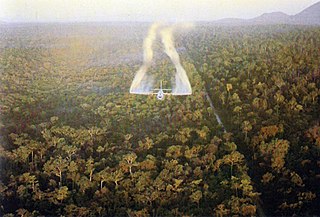 W
WAgent Green is the code name for a powerful herbicide and defoliant used by the U.S. military in its herbicidal warfare program during the Vietnam War. The name comes from the green stripe painted on the barrels to identify the contents. Largely inspired by the British use of herbicides and defoliants during the Malayan Emergency, it was one of the so-called "Rainbow Herbicides". Agent Green was only used between 1962 and 1964, during the early "testing" stages of the spraying program.
 W
WAgent Orange is a herbicide and defoliant chemical, one of the "tactical use" Rainbow Herbicides. It is widely known for its use by the U.S. military as part of its herbicidal warfare program, Operation Ranch Hand, during the Vietnam War from 1961 to 1971. It is a mixture of equal parts of two herbicides, 2,4,5-T and 2,4-D. In addition to its damaging environmental effects, traces of dioxin found in the mixture have caused major health problems for many individuals who were exposed, and their offspring.
 W
WAgent Pink is the code name for a powerful herbicide and defoliant used by the U.S. military in its herbicidal warfare program during the Vietnam War. The name comes from the pink stripe painted on the barrels to identify the contents. Largely inspired by the British use of herbicides and defoliants during the Malayan Emergency, it was one of the rainbow herbicides that included the more infamous Agent Orange. Agent Pink was only used during the early "testing" stages of the spraying program before 1964.
 W
WAgent Purple is the code name for a powerful herbicide and defoliant used by the U.S. military in their herbicidal warfare program during the Vietnam War. The name comes from the purple stripe painted on the barrels to identify the contents. Largely inspired by the British use of herbicides and defoliants during the Malayan Emergency, it was one of the so-called "Rainbow Herbicides" that included the more infamous Agent Orange. Agent Purple and Orange were also used to clear brush in Canada.
 W
WAgent White is the code name for a herbicide used by the U.S. military in its herbicidal warfare program during the Vietnam War. The name comes from the regulatory requirements of identifying each container of the various herbicides through the addition of colored stripes. Orange, purple, blue, and white were colors used by the manufacturers to ensure that the contents were easily identifiable in shipment and use. Colors were selected by the U.S. government. Largely inspired by the British use of herbicides and defoliants during the Malayan Emergency, it was one of the so-called "rainbow herbicides".
 W
WThe American fiber helmet is a type of sun helmet made of pressed fiber material that has been used as part of the military uniform by various parts of the United States Armed Forces, from 1934 to present. As of 2017, the helmet continues to be worn by US military rifle range cadres, as an icon for marksmanship excellence. The helmet is technically not a pith helmet, insofar as it is not constructed from pith material. However, in the more generic sense of design style, this type of sun helmet is modeled similarly to one and thus often referred to in common use as a pith helmet. Additionally, the helmet is not a combat helmet, insofar as it was not originally designed to protect the head during combat. However, the helmet was nonetheless assigned, at various times in the 1930s and 1940s, as combat gear for use in active theaters.
 W
WArmored Troop Carriers (ATC), often called Tangos from the phonetic alphabet for T, were LCM-6 landing craft modified for riverine patrol missions. They were used by the Mobile Riverine Force (MRF) of the United States Army and Navy in the Vietnam War. They were also used by Republic of Vietnam Navy (RVNN) and Khmer National Navy.
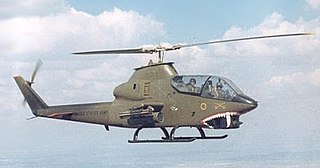 W
WThe Bell AH-1 Cobra is a single-engined attack helicopter developed and manufactured by the American rotorcraft manufacturer Bell Helicopter. A member of the prolific Huey family, the AH-1 is also referred to as the HueyCobra or Snake.
 W
WThe Bell UH-1 Iroquois is a utility military helicopter powered by a single turboshaft engine, with two-bladed main and tail rotors. The first member of the prolific Huey family, it was developed by Bell Helicopter to meet a 1952 US Army requirement for a medical evacuation and utility helicopter, and first flew in 1956. The UH-1 was the first turbine-powered helicopter produced for the United States military, and more than 16,000 have been built since 1960.
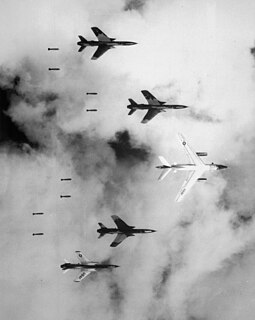 W
WThe American air campaign during the Vietnam War was the largest in military history. The US contribution to this air-war was the largest. Chief of Staff of the United States Air Force Curtis LeMay stated that "we're going to bomb them back into the Stone Age".
 W
WThe Cessna A-37 Dragonfly, or Super Tweet, is an American light attack aircraft developed from the T-37 Tweet basic trainer in the 1960s and 1970s by Cessna of Wichita, Kansas. The A-37 was introduced during the Vietnam War and remained in peacetime service afterward.
 W
WThe Lockheed AC-130 gunship is a heavily armed, long-endurance, ground-attack variant of the C-130 Hercules transport, fixed-wing aircraft. It carries a wide array of ground attack weapons that are integrated with sophisticated sensors, navigation, and fire-control systems. Unlike other modern military fixed-wing aircraft, the AC-130 relies on visual targeting. Because its large profile and low operating altitudes of approximately 7,000 feet make it an easy target, its close air support missions are usually flown at night.
 W
WThe Food Packet, Long Range Patrol or "LRP ration" was a U.S. Army freeze-dried dehydrated field ration. It was developed in 1964 during the Vietnam War (1955–75) for use by Special Operations troops; small, heavily armed long-range reconnaissance teams that patrolled deep in enemy-held territory, where bulky canned MCI rations proved too heavy for extended missions on foot.
 W
WThe Flame Thrower Tank M67 is an American medium flame tank that was briefly used by the U.S. Army, and later by the U.S. Marine Corps during the Vietnam War. It was the last flamethrower tank used in American military service.
 W
WThe Military Armament Corporation Model 10, officially abbreviated as "M10" or "M-10", and more commonly known as the MAC-10, is a compact, blowback operated machine pistol/submachine gun that was developed by Gordon B. Ingram in 1964. It is chambered in either .45 ACP or 9mm. A two-stage suppressor by Sionics was designed for the MAC-10, which not only abates the noise created, but makes it easier to control on full automatic. For a decade, the semi-automatic pistol version of the weapon was forbidden in the U.S. under the assault weapons ban enacted by Congress in 1994.
 W
WNESTOR was a family of compatible, tactical, wideband secure voice systems developed by the U.S. National Security Agency and widely deployed during the Vietnam War through the late Cold War period of the 1980s. NESTOR consists of three systems. The KY-8 was used in vehicular and afloat applications; the KY-28 was the airborne version: and the KY-38 was the portable or man-pack model. About 30,000 NESTOR equipments were produced prior to their replacement by the VINSON secure voice family.
 W
WThe Viet Cong and the North Vietnamese People's Army of Vietnam (PAVN) used well-organized logistics methods to supply and equip their fighting forces. This logistics organization helped greatly in their war against the American and South Vietnamese military during the Vietnam War.
 W
WFarm Gate was the code name for an American air force mission operating in Vietnam before the overt US entry into the Vietnam War.
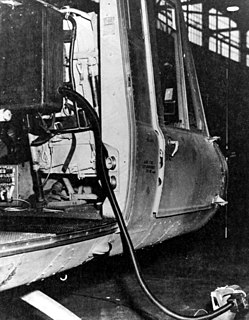 W
WPeople sniffer was the field name for a series of U.S. Army issued "personnel detectors" used during the Vietnam War. The purpose was to detect enemy soldiers in hidden positions, which were often employed in the jungle combat conditions of Vietnam. The U.S. military used two different versions of the people sniffer, one backpack version and one helicopter-mounted version.
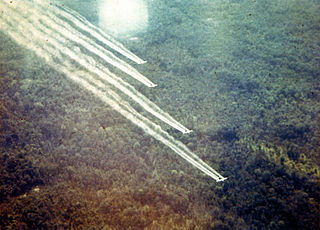 W
WThe Rainbow Herbicides are a group of "tactical use" chemicals used by the United States military in Southeast Asia during the Vietnam War. Success with Project AGILE field tests with herbicides in South Vietnam in 1961 and inspiration by the British use of herbicides and defoliants during the Malayan Emergency in the 1950s led to the formal herbicidal program Trail Dust. Herbicidal warfare is the use of substances primarily designed to destroy the plant-based ecosystem of an agricultural food production and/or to destroy foliage which provides the enemy cover.
 W
WRome plows were large, specially modified armored bulldozers used in South Vietnam by the United States military during the Vietnam War.
 W
WThe Smith & Wesson M76 submachine gun (SMG) was produced by Smith & Wesson from 1967 to 1974.
 W
WWild Weasel is a code name given by the United States Armed Forces, specifically the US Air Force, to an aircraft, of any type, equipped with anti-radiation missiles and tasked with the Suppression of Enemy Air Defenses: destroying the radar and Surface-to-Air Missile installations of enemy air defense systems. "The first Wild Weasel success came soon after the first Wild Weasel mission 20 December 1965 when Captains Al Lamb and Jack Donovan took out a site during a Rolling Thunder strike on the railyard at Yen Bai, some 75 miles northwest of Hanoi."